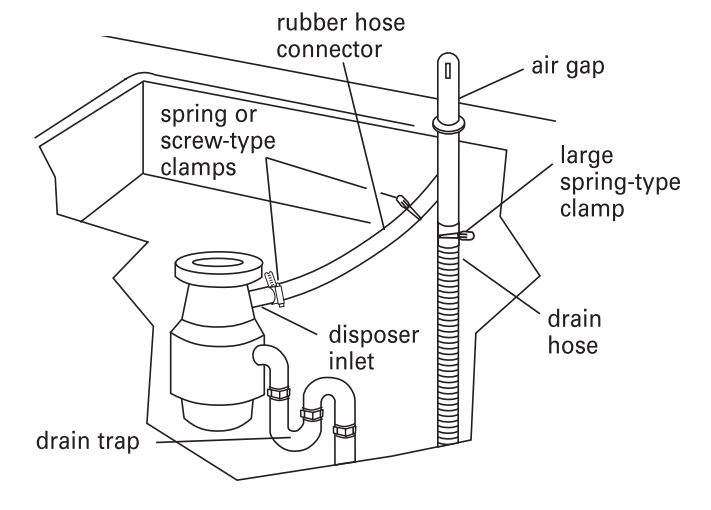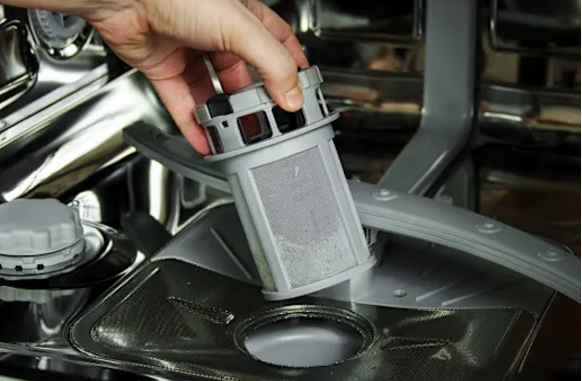How Does a Dishwasher Air Gap Work?

A dishwasher air gap is a simple device installed on the kitchen sink near your dishwasher. Its purpose is to prevent dirty drain water from flowing back into your dishwasher. It also prevents sewage water from your kitchen sink drain from flowing into your dishwasher through the drain hose in the event of a sewage system backup in your home.
While it often goes unnoticed, understanding how it works and addressing issues related to it can save you from costly repairs and ensure your dishwasher runs efficiently.
In this article, we'll look at the mechanics of the air gap, common issues it can cause, and tips for maintaining your dishwasher to avoid problems.
KEY TAKEAWAYS
- The dishwasher air gap is a backflow prevention device that ensures contaminated water (from the kitchen sink drain) cannot flow back into the dishwasher. It uses a physical gap in the drain hose to protect against dirty water entering the dishwasher system, promoting hygiene and preventing damage.
- Problems such as water backing up into the dishwasher, overflowing from the air gap, or gurgling sounds during drainage can indicate clogs or blockages in the air gap or plumbing. Regular cleaning of the air gap and addressing clogs promptly can resolve these issues and maintain proper drainage.
- To prevent air gap and dishwasher issues, regular maintenance is essential. This includes cleaning dishwasher filters monthly, using appropriate detergents, running hot water before starting a cycle, descaling periodically, and ensuring spray arms are clear. Professional maintenance annually can further extend the dishwasher's lifespan and efficiency.
What Is a Dishwasher Air Gap?
The dishwasher air gap is a backflow preventer and anti-siphon device installed in the drain hose system of your dishwasher and attached to the outer rim of your kitchen sink. It creates a short break in the dishwasher drain hose between the bottom of the dishwasher and the drain hose connection on the kitchen sink.
The air gap helps keep your dishwasher sanitary by preventing exposure to contaminated water.
The physical gap that it creates in the drain hose prevents dirty drain water or backed up sink drain water from flowing from the kitchen sink drain into the dishwasher tub through the dishwasher drain system.
While preventing this backflow, it allows dishwasher drain water to flow freely in the proper drain direction through the gap and into the kitchen sink drain during the drain portion of the dishwasher cycle.
Note: Not all dishwasher installations use an air gap.
Here’s a diagram of an air gap installed in a dishwasher drain system.

How Does It Work?
The air gap has two key hoses:
- Inlet Hose: Connects the dishwasher to the air gap.
- Outlet Hose: Links the air gap to the sink drain or garbage disposal.
When your dishwasher drains, water travels through the inlet hose into the air gap. If the drain line is working correctly, the water flows out of the air gap through the outlet hose and into your plumbing system.
If there’s a blockage in the plumbing or drain or drain water backs up through the sink drain, the air gap allows water to overflow safely onto the sink instead of back into the dishwasher.
Signs of Air Gap Problems
A malfunctioning air gap can lead to various dishwasher drain issues. Common symptoms include:
- Water Backing Up Into the Dishwasher: This occurs when the air gap or drain hose is clogged, preventing proper drainage.
- Water Overflowing from the Air Gap: This indicates a blockage downstream in the plumbing system.
- Gurgling Sounds: If you hear strange noises when the dishwasher drains, it may signal a partial clog in the air gap or the drain line.
Troubleshooting Dishwasher Drain Problems and Air Gap Issues
When your dishwasher won’t drain, follow the troubleshooting steps in this popular DIY troubleshooting YouTube video to find and fix the cause of the problem:
The video shows how to take the cover off the air gap and clear an air gap clog.
Over time, food particles and grease can accumulate in the air gap. Regular cleaning prevents clogs and helps maintain optimal performance.
Follow these steps to clean the air gap:
- Pull off the decorative cap.
- Unscrew or pop off the inner cap, depending on your model.
- Rinse both the cap and the air gap body with warm water and soap.
- Reassemble the air gap.
Preventative Maintenance and Usage Tips for Your Dishwasher to Prevent Air Gap Problems
Follow these usage and maintenance tips to keep your dishwasher in top shape and prevent air gap clogs.

Clean Dishwasher Filters Regularly
Your dishwasher’s filters trap food debris and grease. Remove and clean them monthly to avoid clogs and ensure optimal water flow.
Follow the instructions in your owner’s manual to clean the filters in your model.
Use the Right Detergent
Always use dishwasher-safe detergents in the right dosage to prevent residue buildup that can clog hoses and air gaps.
Run Hot Water Before Starting a Cycle
Hot water helps dissolve grease and food particles more effectively, preventing clogs in the system.
Run the hot water at your kitchen sink before starting a cycle so the dishwasher fills with the hottest water possible.
Check Spray Arms
Inspect the spray arms for blockages and clean them as needed to ensure proper water circulation inside the dishwasher.
De-scale Your Dishwasher
Hard water can cause mineral buildup in your dishwasher’s components, including the air gap. Run a cleaning cycle with dishwasher cleaner or vinegar every few months to remove scale.
Avoid Overloading
Overloading your dishwasher can restrict water flow and lead to poor cleaning results. Load dishes according to the manufacturer's guidelines.
Schedule Professional Maintenance
Keep your dishwasher in top shape by scheduling professional dishwasher maintenance service every year. This step will help keep the air gap clear and help you avoid unexpected dishwasher breakdowns. Also, your dishwasher will last longer when it’s professionally maintained.
The dishwasher air gap plays a critical role in preventing contamination and ensuring smooth drainage. By understanding how it works, troubleshooting common issues, and following proactive maintenance tips, you can keep your dishwasher running safely and efficiently for years.
At Sears Home Services, we know appliances. Trust us with all of your home appliance needs.
We’ll help you manage your home so it runs smoothly and efficiently all year long.
Schedule your dishwasher repair now!
With extensive experience, our technicians are skilled in repairing dishwashers of all makes and models, ensuring sparkling clean dishes with every cycle.
Was this information helpful?
Repair Dishwasher Resources
Learn how a rinse aid dispenser works in a dishwasher and how to troubleshoot problems.
Learn how a portable dishwasher works.
Learn how a recirculation pump works in a dishwasher and how to troubleshoot pump problems.
Discover if it's worth fixing a dishwasher with Sears Home Services. Get expert advice and make the right choice.
Glossary Terms
Hard water is water that contains high levels of dissolved minerals, particularly calcium and magnesium. It contrasts with soft water, which has lower concentrations of these minerals.
A ductless range hood, also known as a recirculating hood, filters and recirculates air in the kitchen, removing smoke, heat, and cooking odors without venting outdoors.
A freezer compressor is a vital component of a freezer's refrigeration system, functioning as a pump to circulate refrigerant through the system, which cools the interior by absorbing and expelling heat.
A freezer door gasket is a flexible seal that outlines the edge of the freezer door, ensuring an airtight closure to maintain cold temperatures inside and prevent warm air from entering.
Common Repair Dishwasher Symptoms
The most common reasons your Whirlpool dishwasher won't wash are a faulty pump and motor assembly, defective electronic control board or a clogged spray arm.
The most common reasons your Whirlpool dishwasher won't start cycle are a defective electronic control board, damaged power supply board or a failed door switch.
The most common reasons your Whirlpool dishwasher won't drain are a failed drain pump, faulty pump and motor assembly or a cracked drain hose.
The most common reasons your Whirlpool dishwasher will not spray water are a faulty circulation pump, a clogged spray arm, or a defective electronic control board.
The most common reasons your Whirlpool dishwasher is not working are a defective electronic control board, damaged user interface control or a stripped wire connector.
The most common reasons your Whirlpool dishwasher is not washing are a faulty pump and motor assembly, defective electronic control board or a clogged spray arm.



